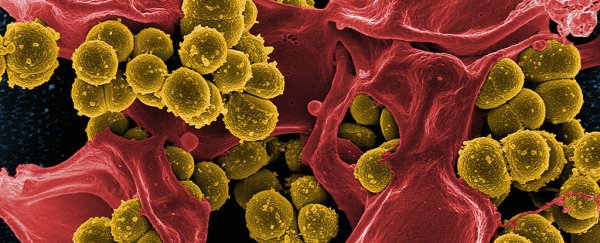Filling a germ's pockets with gold could be a handy way to end an infection. Frustratingly, scientists have struggled to turn this nugget of knowledge into a practical antimicrobial therapy.
Researchers from the Southern University of Science and Technology and Fudan University in China, and the University of Leeds in the UK, recently joined forces to repackage gold nanoclusters to make them more appealing to bacteria and less damaging to our own bodies.
By weaving the gold into two molecules with contrasting levels of electrostatic stickiness, the team built a particle that has the potential to punch holes in the defenses of many common bacterial pathogens without hanging around to harm surrounding tissues.
At first glance, gold might not seem like an obvious treatment for killing germs. Reduced to a fine, nanoscale dust, this heavyweight element is capable of wreaking some serious damage.
One way gold nanoparticles manage this is by facilitating chemical reactions that release oxygen species capable of damaging DNA. Another is to interfere with cell membranes, making them more permeable to various toxic substances, such as antibiotics. They can also absorb light from a laser with great efficiency, heating up and roasting their surrounds.
Unfortunately such handy ways of cleaning up infections don't always discriminate bacteria from host, putting our own cells at risk from gold nanoparticle therapies.
What's needed is a way to encourage bacteria to scoop up as much of the gold as they can, while ensuring our own cells don't do the same.
In recent years, engineers have manipulated the behavior of gold nanoparticles in two ways.
One is to precisely control their size. Keeping the particles under two nanometers helps the particles slip through our kidneys better, making for a quicker exit from our bodies. So the researchers focused on limiting the size of their clusters to just 25 atoms.
The second is to incorporate 'sticky' chemical structures called ligands, bestowing various features that allow them to be easily tracked or help control the particle's shape.
In this case, by applying a positively charged ligand to the clusters, the team hoped the more negatively charged bacterial cells would attract the gold like a sweater attracts cat hair.
Tweaking the particles further to make them even less likely to impact the host's body would go a long way in transforming gold therapy into a clinical reality. But past studies have had little luck capping gold nanoparticles with anything more than a single-type ligand, as methods for integrating ligands with different talents tend to be incompatible.
This time, the team had a winning formula, based on a combination of a positively charged compound called pyridinium and a zwitterion, a compound which has both positively and negatively charged groups.
The pyridinium helps make the gold more attractive to bacteria. The zwitterion was chosen based on past studies that showed improved stability and increased compatibility with animal tissues.
Tested on methicillin resistant Staphylococcus epidermidis (MRSE), the augmented gold nanoclusters had a clear impact on the bacteria's ability to aggregate. It also generated reactive oxygen species, and affected the integrity of its membranes.
Better still, when then dosed with various antibiotics, the bacterium's numbers dropped. In one case, the dose required to inhibit the MRSE's growth decreased more than 100 fold.
Tests on rats with MRSE skin infections helped affirm the gold nanoparticles aided healing without hanging around to become a nuisance.
"By systematically tuning the ratio of the two ligands, we have identified a way of using gold nanoclusters not only to act as effective antimicrobial agents, but as a mechanism to enhance the potency of antibiotics which have become ineffective because of bacterial drug resistance," says Dejian Zhou, a chemical engineer from Leeds.
"The research has a significance on the way we should be thinking about responding to antimicrobial resistance."
Increasing resistance to antibiotics is one of the more pressing problems in modern medicine, threatening to make some of our most prized defenses against infection useless.
Finding new ways to kill off bacteria is all well and good. But finding ways to hold onto our trove of existing treatments would also come as a huge relief.
This could quite literally be a golden opportunity to give us a second chance at protection against diseases that have taken so many lives throughout history.
This research was published in Chemical Science.
